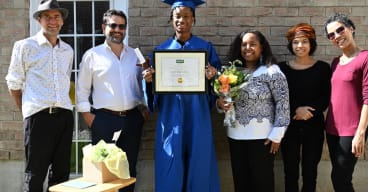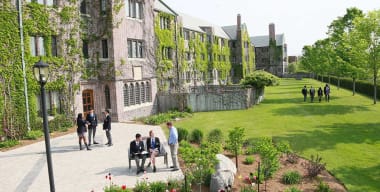The one sure thing is that computers are here. It's difficult to find a private elementary school in Canada that does not have a commitment, even a modest one, to computer learning.
Schools like Balmoral Hall School, a girls' school in Winnipeg, and Kingsway College School (KCS), a coed institution in suburban Toronto, have wholeheartedly embraced the computer.
At KCS, Grade 7 and 8 students spend 40 to 50 percent of their time on their wireless notebooks. In the Balmoral nursery, children as young as three and four are learning their letters and numbers on the computer.
Educational Psychologist Clare Brett is one of Canada's leading researchers on computer use in schools. It comes as a shock when Brett, assistant professor in the curriculum teaching and learning department in the Ontario Institute for Studies in Education of the University of Toronto (OISE/UT), raises a skeptical eyebrow when asked if computers really are helping children to learn better.
"Frankly," she says, "we don't know enough yet." And then the ultimate blasphemy: The difference between children taught traditionally and those taught using the latest computer technology? "Not much, I suspect."
Her view seems to fly in the face of common sense. Since the 1960s, technology prophets such as Seymour Papert, a mathematician who co-founded the Artificial Intelligence Laboratory at MIT, have been tying the future of education to the computer.
"We are entering a digital world where knowing about digital technology is as important as reading and writing," Papert declared in 1999.
Gary Stager, a follower of Papert and a pioneer in laptop education in Australia and the U.S., describes the personal computer as "the most powerful, expressive and flexible instrument ever invented. At its best, the PC offers learners a rich intellectual laboratory and vehicle for self-expression."
Fired by such visions, successive U.S. presidents have committed untold millions to bringing computers to the classroom as a way to tackle America's education malaise. In Canada, while provincial education ministries have accorded varying degrees of priority to computer use in the classroom, there has been no similar concerted federal and corporate push.
But after two decades of big spending, U.S. researchers are agreed there is little to show in terms of improved marks or reduced dropout rates. The only areas where computers have scored is in aiding learning-handicapped students and in making spelling and math drills easier for junior grade kids.
William D. Pflaum, who professes to "an enduring love affair" with computers, spent a year visiting American schools and wrote The Technology Fix: The Promise and Reality of Computers in our Schools (see book review on page 81). Pflaum found that students don't spend enough time on computers to make a measurable difference in performance. "The average student spends about an hour a week with a computer at school. Many spend far less," he says.
As he walked school halls for his book, he rarely found more than one out of five school computers in use. And where computers were used at the elementary level, he saw just how much organizational work was required by teachers to select, become well acquainted with and guide students in the use of appropriate programs. So much time is needed, he said in an interview from his Dayton, Ohio, home, "that for many teachers, the payoff is not there."
Other researchers have faulted the U.S. education system for not training teachers how best to use computers, and for failing to provide the necessary technical backup for teachers. Lack of money is a big part of the story – a note echoed in the Canadian public school system.
But independent schools do not face the same constraints. Parents may blanch at the fees, but one recurrent theme from private school principals is that, when it comes to technology, parents are willing to pay until it hurts.
So, since computers are unlikely to go away, what can educators learn from the private schools that do it best?
To start, though, a fundamental question: Why computers at all?
"They're part of the culture," Balmoral computer teacher Signy Thordarson says. "It's just second nature to (the children) now. They are all so motivated to use the computer, it's no chore... It's made teaching a much nicer job."
Looking further ahead, Glenn Zederayko, head of Kingsway College School, a Grade 1 to 8 school, says: "There is a pragmatic expectation that students will be technologically literate, whether inside or outside the workplace. Technology is not the be-all and end-all, but it allows youngsters to find and evaluate the information that will be important in their lives.
"The result is they will be better educated," he says. "At the same time, they have traditional values and enjoy doing things together."
Undeniably, there is an energy when you walk into Kingsway, tucked into the parking lot of a church in suburban Etobicoke, Ontario. Some things have not changed, however: Grade 2 students are reading books in their classroom near the entrance, kids' art is everywhere, and there's the distant sound of a band practising. In the library, though, there's a hum as some 35 older youngsters use books as well as computers for their rainforest project.
Zederayko insists KCS is not a technology school and that computers are only used where appropriate. The key phrase is "seamless integration."
Kingsway has learned some important lessons: It's not enough to buy hardware – money must be spent to ensure it is used. Some schools, says Zederayko, go days without using their computers, but his school's computer labs are used throughout the day.
Kingsway, with 220 children, has a full-time information technology director, Stacy Marcynuk, and has just added a technology backup person.
At this school, which has a mostly young staff, teachers are told on being hired that it is expected they will be innovative in their use of technology.
Marcynuk says the school's teachers don't use computers just to be flashy, as teachers, it's not their job to get carried away. It can happen: "Kids get excited, teachers get excited. They want to learn more," she says. Her biggest surprise has been how fast kids learn. She started out teaching web design as a Grade 7 subject; now it's a Grade 3 subject.
How soon should computers be introduced? At Kingsway, says Zederayko, Grade 1 students will encounter computers their first week of school. "We are teaching spelling, grammar, math facts, all the basic skills. But what technology allows us to do is apply those skills at a higher level involving research, analysis and presentation."
Youngsters are taught to evaluate information on the Internet rather than accept blindly. Librarian Judy Hoggarth, for instance, tests their gullibility by having them examine the websites of two small towns. One is a fake – but which one?
Childrens' writing also improves with computer use, Zederayko believes. The old way, the good copy was only a slight improvement on the original. On computers, as every writer knows, you learn to shift material around, add or delete, and, with the help of a peer editor, produce something entirely better.
"We can't go hog-wild (buying equipment), but if we say to the parents, we really need this, they will go the extra distance," he says. "They have been very supportive."
At Balmoral, a nursery to Grade 12 school with 550 students, parents are on side as well. "They are happy with anything we can do with technology," says Thordarson. "Many of them are in business and can see the advantage of their child being computer literate."
Within five minutes of making her first appearance as computer teacher in the nursery, "you have 10 of them (children) hanging over you,"– she says. "Every time I go in, there's someone using the computers, learning numbers and letters and colours and shapes. It takes out the (repetition); a little bit of noise and colour and they are enthralled by it." Thordarson previously taught computer skills as a subject; now she doesn't need to – the girls are taught what they need to know in the course of doing projects.
Carlos James, who recently joined Balmoral as information technology (IT) director, believes the earlier children start on computers the better.
"I know kids (aged) two or three using them. They don't really know what they are doing. It's fun on one hand, but they are working. It's learning through play, and that's the best way to reach a child."
Balmoral has paid special attention to the way girls learn. And technology, insists Jackie Copp, the head of academic studies, is a great vehicle for helping girls visualize the abstract. In math, for instance, they are able to combine an equation with a graph and see the information come alive.
Collaboration is basic to project work in schools, an area where girls excel. "You only have to see them working together, discussing, giving their opinions – it's something they thrive on," says Copp.
OISE/UT's Clare Brett doesn't entirely buy that rosy picture of collaboration, although she does not deny the appeal and potential of computer learning. "When it works well, it is very exciting," she says, interviewed in her downtown Toronto office.
"We have done a lot of research on (children) working together," she says, "and some are not learning." Frequently, she explains, a dominant child will take over the group or the girls will let the boys take the lead. "The potential for gender imbalance gets greater as they get older."
Working collaboratively is popular with educators, Brett says, because it is seen as teaching the life skills kids will need later. "But technology does not by itself enable anything. They have to be taught to work collaboratively."
Brett believes parents – and teachers too – should be more questioning, for instance when it comes to those razzle-dazzle PowerPoint presentations. "Once their little darling has taken them through this, hopping from window to window, they are speechless... (But) you can mistake a flashy presentation for real learning."
How much of the presentation, they should ask, is simply pictures and text cut and pasted from websites and how much is genuine research? Teachers and parents should be asking: "What do you understand now that you didn't understand before?" says Brett.
Technology can play a role, even when children are young, but it must be done carefully and in moderation, she says. "It's not a substitute or a solution for anything." Many schools are proud of their laptop programs, "but the point is, if you don't know why you are doing it, they are just misused."
Often too, she adds, schools fail to realize how much planning and time must be given to integrating computers into learning, and that means teachers' time.
If there is little research on how effective computer learning is in elementary schools, the least research of all covers the first four grades. Yet, working with children in Grades 1, 2 and 3, Brett has found their fluency and curiosity on the computer "mind-boggling. They are fearless. Often they are more skilled with the computer than their teachers."
On a broader front, she is concerned schools are being pressured by society and by parents, especially upper-income parents, who see technology as the key to a good job later. Computer literacy is not such a big deal, she believes. Today's adults, herself included, only achieved it in maturity. If you don't learn it at school, "I don't think there's anything you are going to miss that you can never get back," she says.
Brett deplores an overly reverential attitude toward computer learning and is critical of technology, but she does not favour banning computers in the classroom.
Banning may seem extreme, yet that is the position taken by The Alliance for Childhood, a U.S. group that includes pediatricians, psychiatrists and child development experts.
In an eloquent 2000 report titled, "Fool's Gold: A Critical Look at Computers in Childhood," the alliance called for a moratorium on the further introduction of computers in early childhood and elementary schooling. The report repeats the familiar concerns that computers contribute to childhood obesity and social isolation, and points out that the technology kids use today will be obsolete before they graduate.
The report also claims that "the high-tech agenda pushes children to hurry up and become skilled little technicians, experts in assessing other peoples' answers to narrow, technical questions and manipulating machine-generated images." At another point, the authors declare, "When it comes to human childhood, nature is in no hurry at all."
"There is no established consensus on how computers improve the quality of education," says Colleen Cordes, one of the authors of the report. "The research is still being done." The push for computer education, she claims, is coming from the computer and software firms that profit from it.
The "Fool's Gold" view is similar to that promoted by Waldorf School supporters, some of whom were involved in the report's preparation. The Waldorf movement, founded in 1919, now numbers 750 schools worldwide.
"What we try to do at Waldorf is pursue teaching through feelings, always integrating creative expression," says Anne Klar, registrar at Alan Howard Waldorf School in Toronto.
"There is something very attractive about computers (which the school uses at the high-school level)," she admits. "The images are appealing. But the information is cerebral. You can draw and paint on the screen, but the colours are solid. You can't create the subtleties. You can simulate experiences on the computer, but it's not the same as going to a stream and experiencing tadpoles and frogs in nature."
At her school, small children use more traditional techniques to learn their numbers and times tables: rhymes, movements and bean bags. "We want to preserve the essence of childhood," Klar says.
So where is consensus? In the absence of meaningful research results, there are no clear answers.
Jane M. Healy, an educational psychologist and professional educator with more than 35 years of experience, declares herself a computer enthusiast. Yet, in the course of researching Failure to Connect, her book on computers and the growing brain, she concluded that children under seven may be better off without computers, "since flashy technology in the lower grades all too easily distracts children and teachers from the real development tasks at hand: language, social and psychomotor skills to undergird personal and academic success in the future." If these critical periods of brain and body development are missed, she prognosticates, instead of being prepared for the future, they may become "guinea pigs in a failed experiment."
Technology may eventually yield great benefits, Healy says, and is already helping middle school students understand math and science concepts. But, she adds, echoing a conclusion arrived at by many observers, "the good teacher remains an essential ingredient, and is not about to go out of style because we have 'smart machines.'"
OISE/UT's Brett comes down in the middle. "You can have too much (technology) or you can have nothing. Neither extreme is helpful. There are lots of creative things you can do with a computer, just as you can with a pencil or crayon."
More information
The Alliance for Childhood, which promotes children's healthy development, is challenging the increasing emphasis on computers in early childhood and elementary schools. Read their report "Fool's Gold: A Critical Look at Computers in Childhood" (allianceforchildhood.net).
Balmoral Hall School, an all-girls school in Winnipeg using technology in the elementary grades (https://www.balmoralhall.com/).
Clare Brett, assistant professor,? Department of Curriculum, Teaching and Learning (https://home.oise.utoronto.ca/~cbrett/personal/). Gary Stager looks at trends in educational technology, including efforts to delineate technical skills and reinventing elementary education for the new century.stager.org).
Kingsway College School, a Toronto coed school offering Grades 1 to 8 technology in the classroom (kcs.on.ca/).
Seymour Papert, a mathematician who co-founded the Artificial Intelligence Laboratory at MIT and created the LOGO programming language, is considered the grandfather of tying the future of education to the computer (https://www.papert.org).
Office of Educational Technology, U.S. Department of Education (www.ed.gov).
Technology and Children magazine covers technology in elementary education (iteawww.org).









